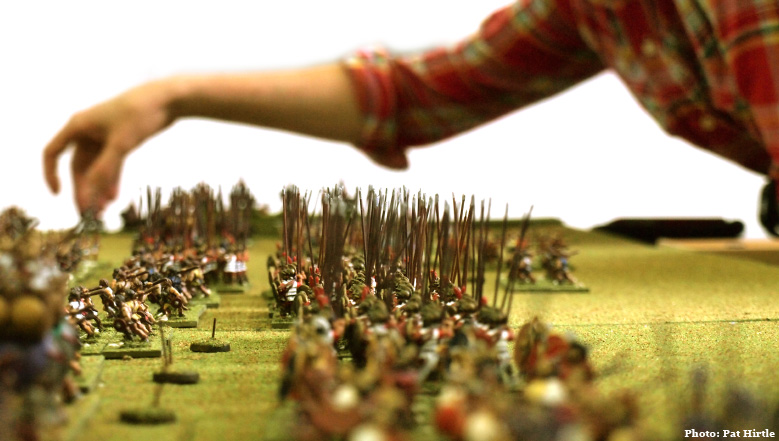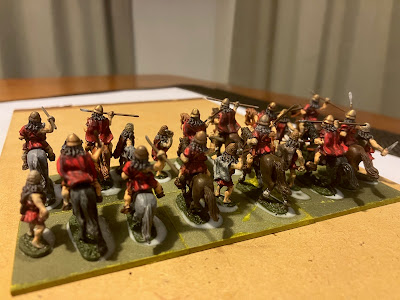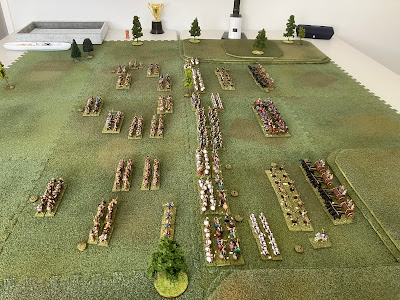Before we get to the action, there are two points to note. One is that for this game I am playing Lost Battles pure; that is, without the Favour of the Gods rule that allows players, when conditions are right, to demand the re-roll of an attack result. Suggested by Charles Vasey, this rule variation was adopted by Phil Sabin for the deluxe board game edition of Lost Battles. Since I am playing solo and feel there is a chance I will use the Favour rule more in aid of one side than the other I have decided this time to play pure, to reduce the chance of - shall we say - authorial intrusion.
 |
| Lines meet in a grassy area of North Africa.... |
The second point is that I will be mentioning lead units. Lead units are a Lost Battles game mechanism requiring one unit to be nominated to take the point position for each zone in the battle line and remain there until either the unit suffers a hit or is replaced by a different lead unit on a subsequent turn.
This mechanism allows advantageous match-ups in attack, but as the lead unit will be the focus of enemy attacks on the other side's turn it is key in defence as well. While in attack, for example, it may seem like a reasonable idea to have a levy heavy cavalry unit in the lead position, it can seem quite unreasonable when it comes time to defend! Decisions around which class of unit to put into the lead position when are part of what makes Lost Battles such an engaging game.
Anyway, enough of that. To the action! We have already seen in a previous post the initial deployment positions (turn 1), so let us move on from there.
Turn 2 - Carthage. 10 commands plus those of the two generals.
In the right centre the chariots take the lead and attack the opposed Syracusan unit of veteran hoplites. Usually requiring a 9 on two dice to hit heavy infantry, the lead unit bonus and a combat bonus purchased from army commands reduces this to 7. A roll of exactly 7 sees the chariotry decide to prosecute an all-out attack (a hit to both the attacking and defending units) to hurt the precious veteran hoplites. Agathocles must attempt a rally. The rally fails, and his own veteran guard, being the only other unit currently in the zone, now takes the lead position. A Carthaginian light infantry attack follows in support of the chariots, but is unsuccessful.
 |
| View from the Syracusan side.In the picture above a spent marker is visible next to the veteran hoplites. The Carthaginian chariots, also spent, have retired from the lead position they held at the start of the attack and are now at the rear of their zone. Since the attack the reinforcing infantry have moved up. |
In the left centre no attacks succeed. The levy heavy cavalry in the central zone demonstrates only in order to allow the more defensively capable infantry to come up and move into the lead position. This was a tricky decision: if Carthage had used the cavalry to attack, they could have scored a hit on a 9, or all-out attack on an 8, but would then themselves be hittable on the Syracusan turn on a 7 (or 6 for an all-out attack) and an increased chance of a double hit (a score 4 above what is needed for a single hit). In this instance caution prevailed.
After the attacks are complete the infantry is brought up into the line in all three central zones.
 |
| View from the Carthaginian left after their turn. Each carpet tile is a separate zone. |
Turn 2 - Syracuse. 12 commands plus those of Agathocles.
The Syracusans are slow to action. Attacks by the forward units in the centre and centre right fail. On the centre left, Agathocles declines to attack so as to preserve himself fresh for later in the battle. If he had attacked, he would have been in the lead position in the next Carthaginian turn and with a corresponding increased risk of being hit or even killed.
The rest of the infantry comes up into line.
 |
| View from behind the Syracusan left center as the lines close. Agathocles can be seen on the left, having left the lead unit duties to some less valuable troops. |
Turn 3 - Carthage. 8 commands plus those of the two generals.
An attack in the centre yields a successful hit. The next attack roll is 12 - 3 above the required 9 - and it is converted into a double hit by an all-out attack. From five fresh units Syracuse is down to two - both hoplites - and Carthage has four of five units fresh. The Syracusans are somewhat rocked by the onslaught.
The attack from the left centre hits the Syracusan veteran light infantry. The roll is actually a double hit, but as the defending lead unit is light infantry supported by wholly fresh heavy infantry, only the first hit counts. No other attacks from this zone are successful. The veteran lights have done their job.
On the right another hit is scored against Agathocles' zone. If he had been in the lead position he would have taken the hit and been forced to attempt a rally.
Five hits to one over the turn. Carthage is inflicting damage.
 |
Spent markers litter the field after the ferocious Carthaginian attack.
|
Turn 3 - Syracuse. 9 commands plus those of Agathocles.
Agathocles' left centre attacks, scoring a double hit on the vulnerable levy light infantry in the lead. Being levy, and with a spent unit in the zone already (meaning they are unable to ignore the second hit like the Syracusan light infantry could the turn before), they are automatically shattered rather than being able to pass the second hit to another unit in the zone. The morale roll is a 2 - safe so far.
The right centre and its formidible hoplites score three hits. The centre scores another. Six hits to none over the turn.
The Syracusans are settling into their work, but there is more to do. Carthage still has three fresh units in its centre left and centre, and four fresh units on the right centre, where Hanno leads the veteran Sacred Band. Syracuse has four, two, and three respectively in the zones opposite.
 |
| Spent units now on both sides. |
Turn 4 - Carthage. 10 commands plus those of the two generals.
The Carthaginian left centre attacks. The average grade units are all spent, so a unit of levy grade infantry is put into the lead role. The attacks score two hits, leaving only two fresh units for the Syracusans in that zone, but the levy will be vulnerable when attacked themselves.
In the centre another two hits see the whole of the Syracusan central zone now spent. All five units spent in just two rounds of attacks. Future hits there will cause units to shatter. Is it time for the Syracusan centre to pull back to buy some time? This will be a question for next turn.
The Carthaginian right then attacks. Tension is high, but the attack fails to score any hits. Carthage has managed four hits to none this turn. Agathocles' army is running out of fresh units, but his own zone is still relatively intact.
Hanno and Bomilcar are in a strong position.
Turn 4 - Syracuse. 11 commands plus those of Agathocles.
Agathocles loads up on attack bonuses where he can. His right centre attacks the lead levy heavy infantry and scores a double hit, shattering the unit outright. The morale test this causes sees the spent light infantry in the same zone rout. Elsewhere, morale holds. No more attacks on this zone succeed.
 |
| View of the Syracusan right centre on the attack. |
In the left centre, Agathocles decides that it is now time for his guard to take the lead position. With his centre in danger he decides to force the issue. His guard unit is assigned a double attack bonus. He is hitting on a 6 (9 for a double hit) or 5 for an all-out attack. He rolls a 10 and a double hit is scored. The next attack also succeeds by converting it to an all-out-attack. The remaining attacks are unsuccessful, but even so there is now only one fresh unit - Hanno with the Sacred Band - left in the zone. It will be a fight between the two leaders' guard units next turn.
In the centre, the Syracusans ponder whether to stay in place or pull back. If they were only facing infantry, pulling back would be a good option. They would about-face and retreat one zone. The enemy following up next turn could move into the vacant space but would not be able to attack; in effect, this would buy a turn's grace for the left and right to try to win the battle. But in this case Carthage has fresh cavalry, and cavalry can move and attack in the same turn. Cavalry attacking spent heavy infantry from the rear would not be a happy proposition. Moreover, to about-turn and move the hoplites out of the zone would require four commands (they don't like to turn around in Lost Battles), so they decide to stay and fight it out.
Their opponents in the lead role are levy heavy infantry. Once more they are vulnerable: another double hit is scored on the lead unit, which shatters the levies outright. A poor morale test then sees the other levy units in the zone flee the field. A subsequent attack also scores a hit, shattering one of the remaining average quality units.
The Carthaginian centre is now reduced to a single spent unit. The decision to stay in place has been vindicated!
Turn 5 - Carthage. 4 commands plus those of the two generals.
With the centre melting away, the chance to defeat the Syracusan there is gone. For Carthage to win now, the formula is simple: Hanno must kill Agathocles. A roll of 1 for commands does not, however, give too many options for attack bonuses.
The left centre attacks first. Two hits are scored, leaving the Syracusan right completely spent. A third hit, which would have caused a unit to shatter, proves elusive.
It is now Hanno's turn. He is in the lead position and needs a 7 to hit Agathocles' guard. He rolls an 11, a double hit! Agathocles is forced to make a rally roll. A high score will cancel the hit; a low roll will kill him. The roll is high and the hit is cancelled. He makes a rally roll for the second hit. The dice are shaken in the hand... again he rolls high. Again the hit is cancelled. Fortune has a favourite! The remainder of the attacks from this zone fail.
There is just the centre to activate. The lone unit there makes its attack. Success! At last a Syracusan unit is shattered.
Carthage is left to rue what might have been.
 |
| The field after Carthage's attacks. |
Turn 5 - Syracuse. 11 commands plus those of Agathocles.
Leading off the with right centre, Syracuse mounts its attack. A double hit is scored on the levy unit in the lead. The unit shatters. As there are four or more Carthaginian units shattered now, the morale test is taken at a -1. A 1 is rolled; there is is a catastrophic morale failure, and the entire army streams from the field.
 |
| A double six does the trick! |
Results:
Carthage scores 6 points from units shattered, 38 from units spent, 18 from the handicap.
Syracuse scores 22 points from units shattered, 42 from units routed, 12 from units and leaders withdrawn.
62 vs 74 - it is a narrow victory to Syracuse.
Thoughts:
Initially the battle seemed to be favouring Carthage, but once Syracuse had punched through the better infantry, the poor quality of Carthage's levy second-line troops told. A succession of double hits allowed Syracuse to quickly reduce Carthage's fighting fitness. The brutal dismantling of the Carthaginian centre in turn 4 turned the battle, but another key moment was Agathocles managing to rally both hits scored against him on turn 5.
It was interesting to see how many double hits were scored across the game. When playing with Favour of the Gods, many double hits are cancelled and re-rolled. Here, playing 'pure', the double hits had a noticeable effect and the battle finished more quickly than I have been used to.
It was enjoyable to play a lesser-known battle in a lesser-known war, and to have such an interesting mix of troops on the table. Fresh hoplites are deadly against heavy infantry!
I might leave the table set up and see if SP and I can find time for a game this coming weekend.
** with thanks to Duncan Head, the original account of the battle can be found in Diodorus, here.






























